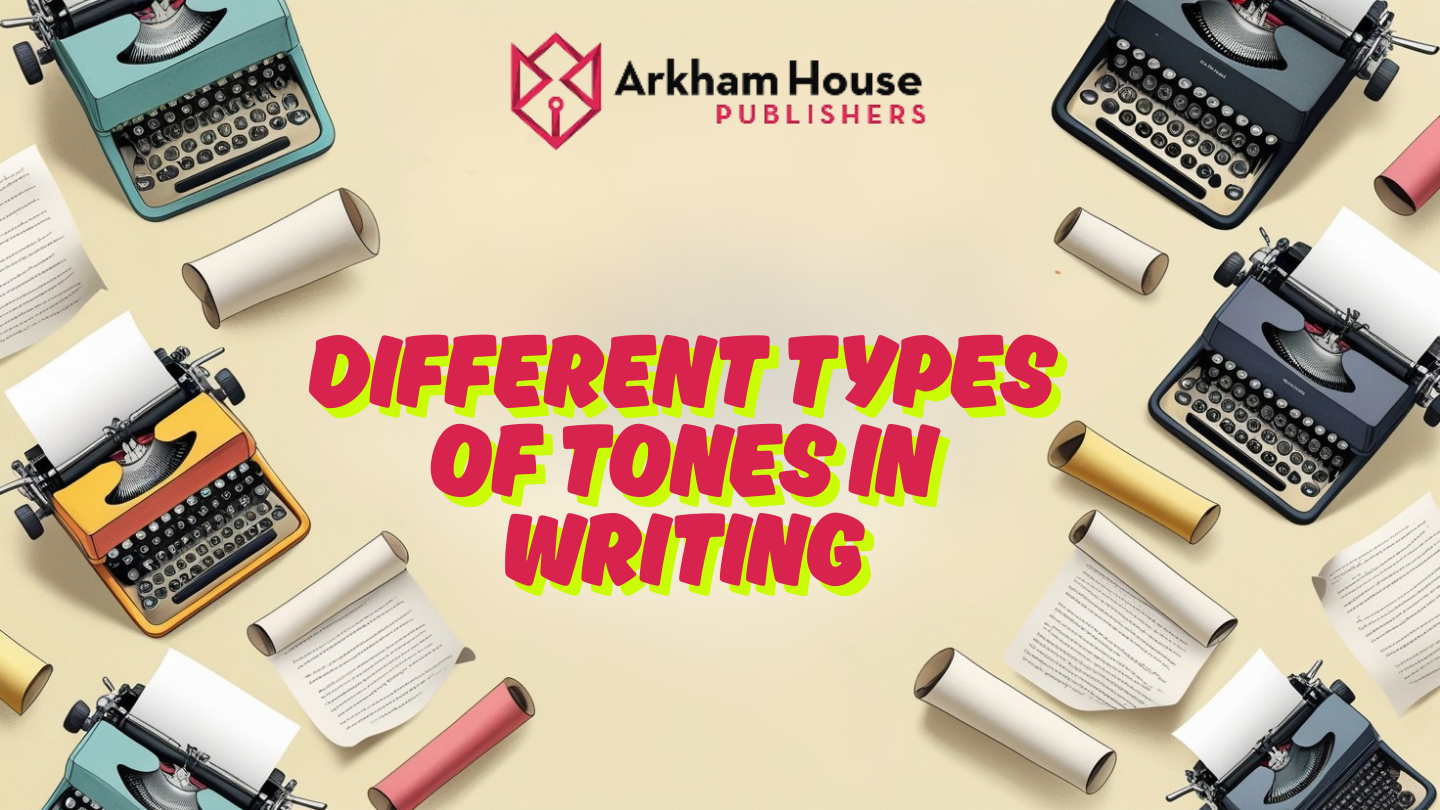“Words whisper or shout, charm or scold—the magic isn’t in what you say, but how you say it.”
– A wise editor’s coffee mug
Ever opened an email that made you feel like you were being scolded? Or started a novel that couldn’t decide if it wanted to be a comedy or a tragedy? That’s tone at work the invisible seasoning that makes your words taste sweet, sour, or just plain bland.
Here’s the deal:
- A resume that says, “Hey, I’m kinda awesome, wanna hire me?” goes directly into a trash bin.
- A kids’ book that reads “The domesticated feline ascended the deciduous vegetation” induces a snore fest.
- An ad that whispers, “Our product might work… or it might not,” is definitely a sales disaster.
This isn’t just writer talk it’s life-or-death for emails, social posts, and even texts to your mom. Nail the tone, and readers lean in. Miss it, and they’re gone faster than free doughnuts at the office.
This is why understanding the types of tones in writing isn’t just for authors it’s essential for business communicators, students, marketers, and social media managers.
In this guide, we’ll unpack:
- What tone really is (hint: it’s not just “fancy style”)
- 8 major types of tone with real-world examples (from boardrooms to TikTok)
- How to pick the perfect tone like a pro
- Why Old Spice’s absurd humor and Apple’s sleek simplicity use different tones of voice in writing.
First, let’s clear up the big confusion…
What Is the Tone of Writing?
The tone is the attitude or emotional vibe your words convey, whether friendly, formal, sarcastic, or sincere. It’s not what you say but how you say it.
Example:
“Submit the report by 5 PM.” (Authoritative)
“Hey team, let’s wrap up those reports by 5!” (Collaborative)
One way or another, tone shapes how readers perceive you. It can build trust, clarity, or connection in seconds.
Tone vs. Voice: What’s the Difference?
Tone = Your mood ring
It changes based on who you’re talking to. For instance, look at these examples again:
- “Report due by 5 PM.” → All-business boss
- “Team, let’s crush these reports by 5!” → Supportive coach
- “Miss the 5 PM deadline, and Accounting Karen will hunt you down.” → Office joker, basically humorous
Voice = Your fingerprint
It’s the you that stays consistent:
- Hemingway’s voice was always blunt and beer-loving, whether he wrote war novels or fishing stories
Why Bother?
- First impressions: Readers judge you in 3 seconds flat
- Connection: Warm tone = trust, robotic tone = snooze
- Clarity: The wrong tone turns “Click here to save money” into “Please initiate the fiscal optimization portal.”
Golden Rule: Read your writing aloud. If it sounds like you’re talking to a real human, you’re winning. If it sound like a Wikipedia edit? Red alert.
The 8 Personality Types of Tones in Writing (And When to Use Them)
Think of tone like outfits you wouldn’t wear a ball gown to the gym (unless you’re Lady Gaga).
Let’s explore the most important types of tones in writing, illustrated with examples from literature, marketing, and everyday communication. But before exploring these eight essential different kinds of tones, it is important to remember that most great writing blends multiple tones strategically.
- The CEO (Formal Tone)
Wear it to: Courtrooms, lab reports, shareholder meetings
Example:
- “Q3 expenditures surpassed projections by 18% due to unanticipated commodity price volatility.”
- Not: “Whoops, we spent too much ‘cause the economy went bonkers.”
-
Your BFF (Conversational Tone)
Wear it to: Blogs, Instagram, emails to coworkers
Example:
- “Don’t buy that yet! Let’s find something better together.”
- Not: “Consumers are advised to conduct comparative analysis prior to purchase.”
-
The Class Clown (Humorous Tone)
Wear it to: Memes, witty bios, creative brands
Example: Douglas Adams’ legendary Hitchhiker’s Guide opener:
“Space is big. Really big. You just won’t believe how vastly, hugely, mind-bogglingly big it is.”
-
The Brainiac (Authoritative Tone)
Wear it to: Medical advice, how-to guides, crisis statements
Example:
- “NASA data confirms sea levels are rising 3.4mm yearly.”
- Not: “I read somewhere that oceans might be getting taller?”
-
The Motivational Coach (Inspirational Tone)
Wear it to: TED Talks, nonprofit campaigns, pep talks
Example:
- “Your idea is a seed, water it with action, and watch it grow.”
-
The Fire Alarm (Urgent Tone)
Wear it to: Flash sales, emergency alerts
Example:
- “24 hours left to claim your bonus, tick tock!”
-
The Therapist (Empathetic Tone)
Wear it to: Customer service, healthcare, and apology emails
Example:
- “I hear how frustrating this must be let’s fix it together.”
-
The News Anchor (Neutral Tone)
Wear it to: Encyclopedias, fact sheets
Example:
- “Studies link the policy to a 22% poverty increase.”
- Not: “The evil policy destroyed lives!”
Pro Hack: Record yourself explaining your topic to a friend, then transcribe it. Boom instant natural tone!
How Authors and Brands Master Tone Shifting
The shifting of the tone of an author is based on three key factors: audience, purpose, and medium. Let’s examine how this works in practice.
Audience Dictates Tone
Children’s authors like Dr. Seuss use playful rhymes and exaggerated characters, while legal scholars writing for peers adopt dense, citation-heavy prose. A social media manager might post:
- LinkedIn: “Our Q3 results demonstrate robust growth in key sectors.”(Professional)
- Twitter: “Guess who crushed their goals this quarter? “(Celebratory)
- Purpose Shapes Voice
Consider how the same company discusses a product:
- Instruction manual: “Align Tab A with Slot B until audible click occurs.”(Technical)
- Advertisement: “Say hello to your new favorite gadget!”(Enthusiastic)
- Apology for defects: “We sincerely regret any inconvenience caused.”(Contrite)
- Medium Matters
Text messages demand brevity and informality (“Running late—see you at 7!”), while wedding invitations call for elegance (“The honor of your presence is requested…”). An academic might write:
- Journal article: “The phenomenological analysis revealed three recurrent themes.”
- Conference talk: “Here’s what surprised us in the data…”
- Case Study: Brand Tone Evolution
Old Spice transformed its image from “your grandfather’s aftershave” to a viral sensation by switching from stiff, old-fashioned messaging (“The mark of a man.”) to absurdist humor (“Look at your man, now back to me…”). This demonstrates how tones of voice in writing can redefine public perception.
Choosing the Right Tone: A Practical Framework
Selecting the appropriate tone of an author isn’t about guesswork, it’s a strategic decision. Use this step-by-step framework to align your when writing a book.
Step 1: Define Your Audience’s Expectations
A CEO reading a quarterly report expects analytical precision, while a teenager scrolling Instagram responds to casual humor. Ask:
- What emotions should my tone evoke? (Trust? Excitement?)
- How familiar is my audience with jargon?
- What tone do competitors/peers use successfully?
Example: A cybersecurity firm writing for IT professionals might use a technical + urgent tone (“Zero-day exploits require immediate patching”) while explaining breaches to the public demands a clear + cautionary tone (“Here’s how to protect your family’s data”).
Step 2: Match Tone to Purpose
- Persuading? → Confident, data-driven (“Our solution reduces costs by 30%.”)
- Explaining? → Neutral, structured (“The process involves three phases…”)
- Entertaining? → Witty, conversational (“Plot twist: Oatmeal is actually delicious.”)
Step 3: Test and Refine
- Read aloud: Does it sound like a real person speaking to your audience?
- A/B test: Try two tones (e.g., formal vs. friendly) on a small reader sample.
- Audit periodically: Tones can stale update as your brand or audience evolves.
Putting It All Together
Now that you’ve met all eight-tone personalities, here’s the real secret: great writing often blends multiple tones. Think of it like making the perfect cocktail – maybe 2 parts authoritative with a splash of conversational or mostly inspirational with a twist of urgent.
The key is to always keep your audience in mind. What works for a Gen Z TikTok audience will flop with corporate executives and vice versa. When in doubt, remember: the best tone is the one that makes your reader feel understood and respected.
Want to see this in action? Compare Old Spice’s absurdly funny “(“Look at your man, now back to me…” campaign with Apple’s sleek, minimalist product descriptions. Both work brilliantly for their respective audiences because they’ve mastered tone.
So go forth and experiment! Try on different tones like you’re in a writing dressing room. With practice, you’ll develop an instinct for exactly which tone to use and when. And before you know it, you’ll be wielding tone like a literary superhero – saving boring content one well-chosen word at a time.
Why Mastering Tone Transforms Your Writing
The types of tones in writing are more than stylistic choices they’re psychological tools that determine whether your message connects or collapses. Like a skilled musician adjusting their volume and tempo for different crowds, writers must modulate tone to resonate with each unique audience.
Why This Matters Now
In our attention-starved digital age, readers decide within seconds whether to engage. A mismatched tone like using corporate jargon in a parenting blog, creates instant disconnect. Conversely, the right tone acts as a gravitational pull, drawing readers deeper into your content, whether you’re explaining, entertaining, or persuading.
A well-chosen tone:
- Builds trust (Empathetic customer service replies)
- Clarifies complexity (Simple metaphors in science communication)
- Drives action (Urgent fundraising appeals)
Final Checklist for Authors:
- Audit past work: Highlight sentences that represent your ideal tone.
- Create swipe files: Save examples of tones you admire.
- Partner wisely: Collaborators should understand your tonal goals.
Pro Tip:
At Arkham House Publishers, we offer tone analysis to help authors and brands find their perfect voice for their writing projects; schedule a consultation today.
Final Tip:
When in doubt, read your work to someone from your target demographic. Their facial reactions reveal tonal missteps better than any algorithm.





